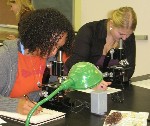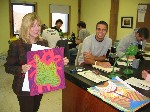Posted on Friday, November 7, 2008
When 15 art students and Professor Peggy Cox want to draw, paint and interpret nature where do they go? Outside, of course. To the Field Station, of course!
Early in the fall semester when everything is vibrant they come to sketch the white oak that belongs to Mrs. Virginia Offutt and sunflowers that were planted by Dr. Ann Throckmorton for her classes. When the autumn colors appear and the leaves fall from the white oak, they interpret those events even with abstract forms and figures interspersed among the dying remains of nature.
And what else are students of art and nature able to do? Draw what they see under the lens of a microscope! Their views are not limited to the biological functions of xylem and phloem (although they are given a brief insight into the respective physiological role of each tissue). They look at and interpret form and relationships . . . big things and small things, colorful things and drab things. They were encouraged to take a look at the common pine cone, actually a female pine cone, with its varying size and patterns over the three-year life of the cone. Stained thin sections of cones on microscope slides were there for viewing. Whether or not students were interested in the sequence of events -- pollination, fertilization and seed production -- they got close enough to the pine to see symmetry and size, pattern and color as the sections of pine cones were viewed microscopically.
These anecdotal comments are offered as evidence that the Field Station has no limits of use. The fact to be emphasized is that this arm of Westminster College has vitality in all fields, not just the sciences. If I estimate the number of people-hours of goings-on here in the past year, there would be lopsided numbers in favor of the non-science-based activities! These would include scouts, pre-schoolers, church groups, runners/walkers, visitors, Kiwanians, Halloween trail spookers, alumni and volunteers. Without these diverse and colorful folk showing widespread interest and involvement we would be just another place on the Westminster College campus.
What do the winter months hold for us? We are open to having community and college club meetings, inside lectures, youth meetings and just about any worthwhile event that has need for a get-away from the usual. And, for those who know us, the composting operation goes on year-round. Volunteers are needed. There is no stopping the processes that convert our usual food and yard wastes into the blessed compost that in spring will allow the plants of next season's bounty to inspire us all. Basically we are all artists of one sort or another and the Field Station is for all seasons.
Clarence Harms, Director
Field Station


